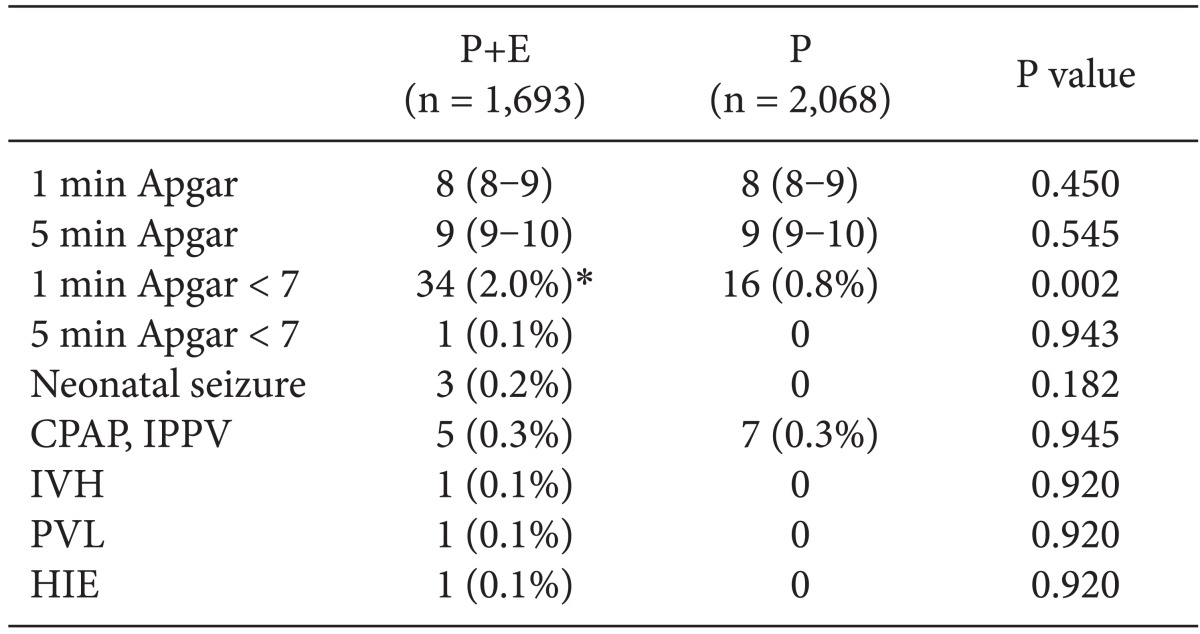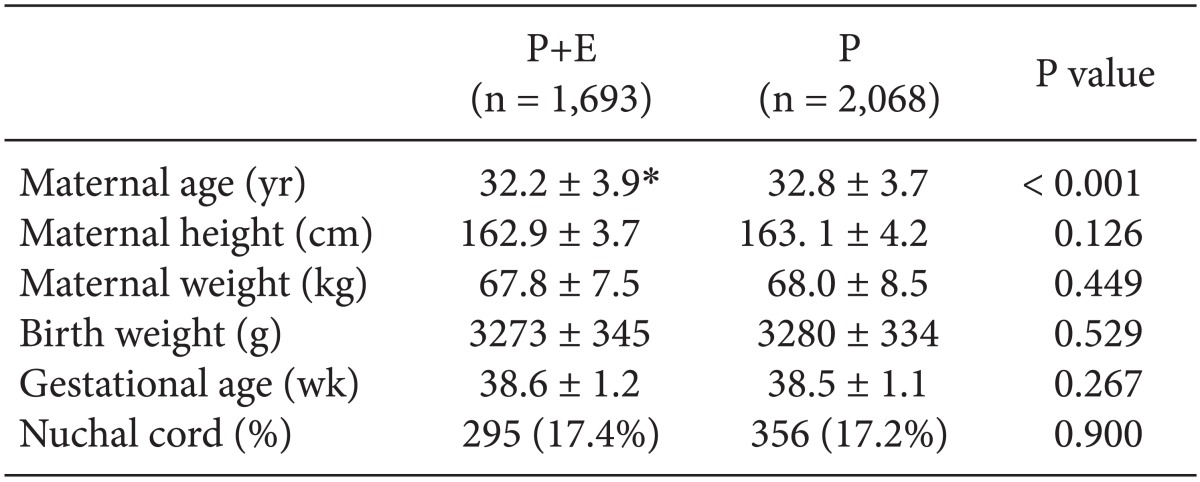1. Rout CC, Rocke DA, Levin J, Gouws E, Reddy D. A reevaluation of the role of crystalloid preload in the prevention of hypotension associated with spinal anesthesia for elective cesarean section. Anesthesiology. 1993; 79:262–269. PMID:
8192733.

2. Banerjee A, Stocche RM, Angle P, Halpern SH. Preload or coload for spinal anesthesia for elective Cesarean delivery: a meta-analysis. Can J Anaesth. 2010; 57:24–31. PMID:
19859776.

3. Prakash S, Pramanik V, Chellani H, Salhan S, Gogia AR. Maternal and neonatal effects of bolus administration of ephedrine and phenylephrine during spinal anaesthesia for caesarean delivery: a randomised study. Int J Obstet Anesth. 2010; 19:24–30. PMID:
19665364.

4. Dyer RA, Reed AR, van Dyk D, Arcache MJ, Hodges O, Lombard CJ, et al. Hemodynamic effects of ephedrine, phenylephrine, and the coadministration of phenylephrine with oxytocin during spinal anesthesia for elective cesarean delivery. Anesthesiology. 2009; 111:753–765. PMID:
19741494.

5. Ngan Kee WD, Khaw KS, Tan PE, Ng FF, Karmakar MK. Placental transfer and fetal metabolic effects of phenylephrine and ephedrine during spinal anesthesia for cesarean delivery. Anesthesiology. 2009; 111:506–512. PMID:
19672175.

6. Cooper DW, Carpenter M, Mowbray P, Desira WR, Ryall DM, Kokri MS. Fetal and maternal effects of phenylephrine and ephedrine during spinal anesthesia for cesarean delivery. Anesthesiology. 2002; 97:1582–1590. PMID:
12459688.

7. Ngan Kee WD, Lee A, Khaw KS, Ng FF, Karmakar MK, Gin T. A randomized double-blinded comparison of phenylephrine and ephedrine infusion combinations to maintain blood pressure during spinal anesthesia for cesarean delivery: the effects on fetal acid-base status and hemodynamic control. Anesth Analg. 2008; 107:1295–1302. PMID:
18806043.

8. Ross MG, Gala R. Use of umbilical artery base excess: algorithm for the timing of hypoxic injury. Am J Obstet Gynecol. 2002; 187:1–9. PMID:
12114881.

9. Low JA, Panagiotopoulos C, Derrick EJ. Newborn complications after intrapartum asphyxia with metabolic acidosis in the term fetus. Am J Obstet Gynecol. 1994; 170:1081–1087. PMID:
8166190.

10. van den Berg PP, Nelen WL, Jongsma HW, Nijland R, Kollee LA, Nijhuis JG, et al. Neonatal complications in newborns with an umbilical artery pH < 7.00. Am J Obstet Gynecol. 1996; 175:1152–1157. PMID:
8942481.
11. Cooper DW, Gowni RR. Impact of changing from ephedrine to phenylephrine as the first-line vasopressor during urgent caesarean section. Int J Obstet Anesth. 2006; 15:339–340. PMID:
16949273.

12. Veeser M, Hofmann T, Roth R, Klöhr S, Rossaint R, Heesen M. Vasopressors for the management of hypotension after spinal anesthesia for elective caesarean section. Systematic review and cumulative meta-analysis. Acta Anaesthesiol Scand. 2012; 56:810–816. PMID:
22313496.

13. Malin GL, Morris RK, Khan KS. Strength of association between umbilical cord pH and perinatal and long term outcomes: systematic review and meta-analysis. BMJ. 2010; 340:c1471. PMID:
20466789.

14. Apgar V. A proposal for a new method of evaluation of the newborn infant. Curr Res Anesth Analg. 1953; 32:260–267. PMID:
13083014.

15. Moster D, Lie RT, Irgens LM, Bjerkedal T, Markestad T. The association of Apgar score with subsequent death and cerebral palsy: A population-based study in term infants. J Pediatr. 2001; 138:798–803. PMID:
11391319.

16. Ayorinde BT, Buczkowski P, Brown J, Shah J, Buggy DJ. Evaluation of pre-emptive intramuscular phenylephrine and ephedrine for reduction of spinal anaesthesia-induced hypotension during Caesarean section. Br J Anaesth. 2001; 86:372–376. PMID:
11573527.

17. Adigun TA, Amanor-Boadu SD, Soyannwo OA. Comparison of intravenous ephedrine with phenylephrine for the maintenance of arterial blood pressure during elective caesarean section under spinal anaesthesia. Afr J Med Med Sci. 2010; 39:13–20. PMID:
20632667.
18. Ngan Kee WD, Khaw KS, Lau TK, Ng FF, Chui K, Ng KL. Randomised double-blinded comparison of phenylephrine vs ephedrine for maintaining blood pressure during spinal anaesthesia for non-elective Caesarean section
*. Anaesthesia. 2008; 63:1319–1326. PMID:
19032300.
19. Ngan Kee WD, Khaw KS, Tan PE, Ng FF, Karmakar MK. Placental transfer and fetal metabolic effects of phenylephrine and ephedrine during spinal anesthesia for cesarean delivery. Anesthesiology. 2009; 111:506–512. PMID:
19672175.

20. Jung SW, Kim EJ, Min BW, Ban JS, Lee SG, Lee JH. Comparison of Maternal and Fetal Effects of Ephedrine and Phenylephrine Infusion during Spinal Anesthesia for Cesarean Section. Korean J Anesthesiol. 2006; 51:335–342.

21. Victory R, Penava D, Da Silva O, Natale R, Richardson B. Umbilical cord pH and base excess values in relation to adverse outcome events for infants delivering at term. Am J Obstet Gynecol. 2004; 191:2021–2028. PMID:
15592286.

22. Sykes GS, Molloy PM, Johnson P, Gu W, Ashworth F, Stirrat GM, et al. Do Apgar scores indicate asphyxia? Lancet. 1982; 1:494–496. PMID:
6121150.

23. Committee on Obstetric Practice, ACOG. American Academy of Pediatrics; Committee on Fetus and Newborn, ACOG. ACOG Committee Opinion. Number 333, May 2006 (replaces No. 174, July 1996): The Apgar score. Obstet Gynecol. 2006; 107:1209–1212. PMID:
16648434.
24. Thorngren-Jerneck K, Herbst A. Low 5-minute Apgar score: a population-based register study of 1 million term births. Obstet Gynecol. 2001; 98:65–70. PMID:
11430958.

25. Nelson KB, Ellenberg JH. Apgar scores as predictors of chronic neurologic disability. Pediatrics. 1981; 68:36–44. PMID:
7243507.

26. Richardson BS, Czikk MJ, daSilva O, Natale R. The impact of labor at term on measures of neonatal outcome. Am J Obstet Gynecol. 2005; 192:219–226. PMID:
15672028.

27. Roofthooft E, Van de Velde M. Low-dose spinal anaesthesia for Caesarean section to prevent spinal-induced hypotension. Curr Opin Anaesthesiol. 2008; 21:259–262. PMID:
18458538.

28. McNaught AF, Stocks GM. Epidural volume extension and low-dose sequential combined spinal-epidural blockade: two ways to reduce spinal dose requirement for caesarean section. Int J Obstet Anesth. 2007; 16:346–353. PMID:
17693082.

29. Casey BM, McIntire DD, Leveno KJ. The continuing value of the Apgar score for the assessment of newborn infants. N Engl J Med. 2001; 344:467–471. PMID:
11172187.

30. Serunian SA, Broman SH. Relationship of Apgar scores and Bayley mental and motor scores. Child Dev. 1975; 46:698–700. PMID:
1157607.






 PDF
PDF Citation
Citation Print
Print



 XML Download
XML Download